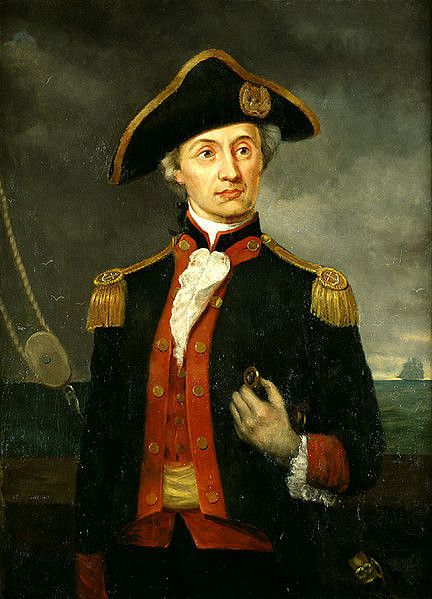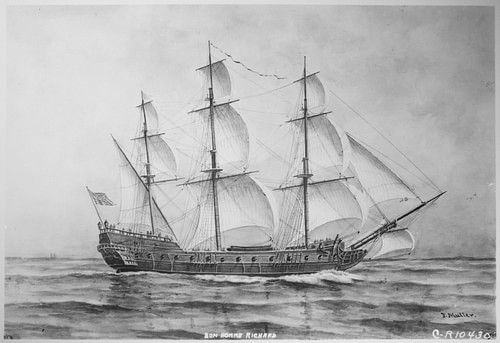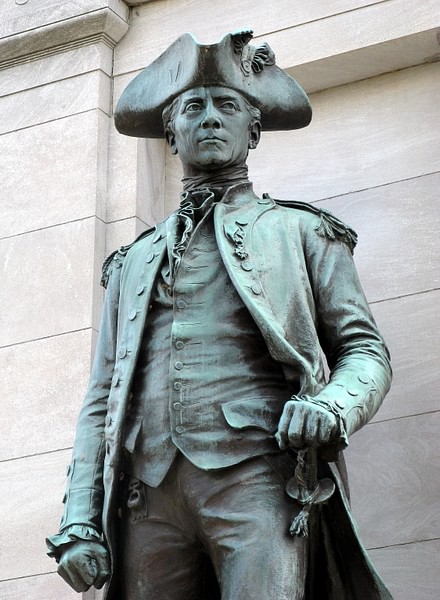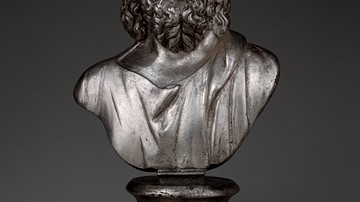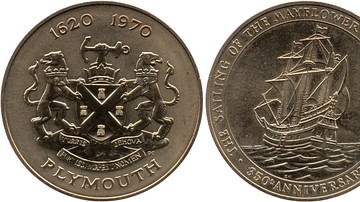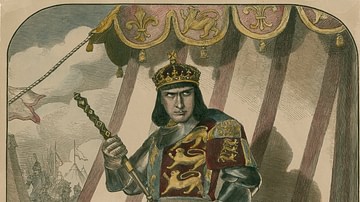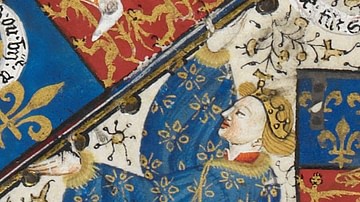The Battle of Flamborough Head (23 September 1779) was one of the most famous naval engagements of the American Revolutionary War (1775-1783). Fought off the coast of Yorkshire, England, it pitted the USS Bonhomme Richard, commanded by John Paul Jones, against a Royal Navy frigate, HMS Serapis. The engagement was an important victory for the burgeoning Continental Navy.
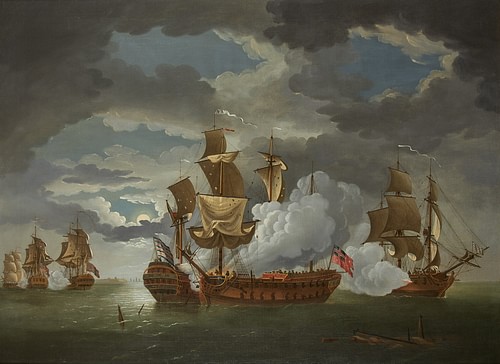
The Expedition Sets Sail
On 14 August 1779, a small fleet of seven vessels set sail from the port of Groix, France, with the intention of wreaking as much havoc as possible in the British Isles. The Kingdom of France had officially entered the American Revolutionary War the year before as an ally of the fledgling United States and had since provided the Americans with military and financial aid. The French had outfitted the ships for the expedition including the flagship, a 42-gun converted merchant vessel called the Duc de Duras, which was gifted to the United States. The makeshift fleet was under the overall command of Captain John Paul Jones, a Scottish-born officer of the Continental Navy, who had recently won international fame for his daring raid on the English port town of Whitehaven in April 1778.
Prior to sailing, Jones renamed the Duc de Duras to the USS Bonhomme Richard; this was in honor of his friend, Benjamin Franklin, whose celebrated Poor Richard's Almanac was translated into French as Les Maximes du Bonhomme Richard. The other ships under his command included the 36-gun frigate USS Alliance, the 32-gun frigate USS Pallas, the 12-gun corvette USS Vengeance, and the cutter Le Cerf, as well as two privateering vessels, the Monsieur and the Granville. Since the ships were setting sail from France, they were mainly crewed by French sailors (except for the Bonhomme Richard itself) and were captained by French naval officers. After raising anchor on 14 August, the fleet sailed toward the southern coast of Ireland.
Trouble beset the expedition almost immediately. On 18 August, they recaptured a Dutch vessel that had previously been taken by a British privateer. The captain of the Monsieur raided the cargo hold of the captured vessel, taking what he pleased before selecting a prize crew to sail it back to Belgium for sale. Jones overrode these orders, however, putting his own prize crew in place and sending it back to France to be sold in his own name. This enraged the captain of the Monsieur, who felt entitled to the prize. That night, the Monsieur abandoned the fleet with the other privateer, Granville, leaving not long after. Jones was hardly surprised by the disloyalty of the privateers but would soon be faced with more discontent from within his ranks. The aristocratic French naval officers under his command despised taking orders from a provincial, Scottish-born American and were not afraid to show their displeasure; Pierre Landais, captain of USS Alliance, was the most outspoken of this group, flatly telling Jones that he intended to sail Alliance as he saw fit.
After the departure of the privateers, Jones' remaining five ships sailed up around the southwest of Ireland before heading north. In late August, Jones sent Le Cerf to reconnoiter the Irish coast, but the cutter soon became lost; after failing to find its way back to the fleet, Le Cerf turned around and sailed back to France. Jones, meanwhile, continued northward with his remaining ships, sailing along the coast of Scotland. Despite the expedition's rocky start, it finally began to prove profitable, as the Franco-Americans took several British merchant vessels as prizes along the Scottish coast. On 3 September, Jones' fleet rounded the Orkney Islands and turned south. He put a landing party ashore at Leith, the seaport of Edinburgh, with instructions to threaten to burn the port unless the residents paid a large ransom. But before the threat could even be made, a strong gale blew Jones' ships away from the bay, forcing him to call off the raid. Nevertheless, the sight of Jones' fleet off the coast of Scotland was enough to cause panic and alarm throughout Great Britain.
The Convoy
On 15 September, as John Paul Jones was busy striking fear into the seaside towns of Britain, a convoy of 50 British merchant ships was setting sail from a rendezvous point off the coast of Norway. The convoy was escorted by the HMS Serapis, a newly built, 42-gun copper-bottomed frigate, as well as the 20-gun sloop-of-war Countess of Scarborough. As they neared Britain, several of the merchant ships departed from the convoy to head for port, and by 23 September, 40 ships remained, most of them carrying iron or timber. By this point, the Serapis was on high alert; it had learned from passing ships that Jones' fleet was in the vicinity. The frigate signaled to all merchant vessels to stay close for their own protection.
Early in the afternoon, the convoy approached Flamborough Head, on the coast of Yorkshire. Here, the lookouts of several of the merchant ships spotted a cluster of vessels that seemed to match the description of Jones' squadron. In a panic, the merchant ships turned around and began to sail for the safety of the seaside town of Scarborough. While the smaller Countess of Scarborough sailed with the convoy to ensure that none of the ships became separated, the larger Serapis raised its sails to get in between the approaching strangers and the fleeing merchant ships. When the convoy was a safe distance away, Serapis signaled for Countess to rejoin it. The two Royal Navy ships then positioned themselves so that the approaching squadron could not sail around them to chase the merchant ships. The time was just after 4 p.m.
The strange squadron was, of course, that of John Paul Jones. His lookouts had spotted the Royal Navy warships and correctly identified them as Serapis and Countess of Scarborough. Jones must have known that attacking the enemy ships would be risky; after all, his flagship was missing several officers and men who had been sent back to France aboard prize ships, and those who remained were inexperienced. Furthermore, the French officers captaining the other ships in the squadron were unreliable. Nevertheless, the allure of taking on one of His Majesty's warships was too much for Jones to resist. He sailed Bonhomme Richard toward Serapis, signaling for Alliance, Pallas, and Vengeance to follow. He ordered Pallas to sail directly in Bonhomme Richard's wake, to conceal their true numbers from the enemy.
Bonhomme Richard was armed with 6 18-pounder guns, 14 12-pounders, 14 9-pounders, and 4 6-pounders. It was crewed by about 380 men and boys, mostly Americans, with 20 French marines stationed at the poop deck. There were also close to 100 prisoners onboard, seven of whom accepted Jones' offer to fight. Serapis, meanwhile, was armed with fifty guns despite being rated as a 42-gun ship; these included 20 18-pounders, 20 9-pounders, and 10 6-pounders. It was crewed by 305 officers and men (Norton).
The Duel Begins
Shortly after 6:30 p.m., Jones signaled for his vessels to form a single-file line of battle. However, Captain Landais, still in command of Alliance, had other plans. He veered off course and sailed against the wind, acting as if he were going after the convoy. The Countess of Scarborough took the bait and sailed off to counter Alliance, leaving Serapis to deal with the three other Franco-American ships on its own. At around 7 p.m., as night settled on the calm sea, Bonhomme Richard came within hailing distance of the Serapis. Captain Richard Pearson, commander of the British frigate, called out: "What ship is this?", to which Jones responded, "Come a little nearer, and I will tell you" (Norton). Pearson once again demanded that Jones identify himself, threatening to fire if he received no answer. A tense silence fell between the two ships and when it became clear that Jones was not going to respond, the Serapis opened fire, to which Bonhomme Richard responded with a broadside of its own.
The first broadside exchange caused two of Jones' 18-pounders to burst, with several men falling killed or maimed in the explosions. As Jones dealt with the carnage, Serapis maneuvered to face Bonhomme Richard's stern; the Royal Navy frigate was much faster than its opponent, and Bonhomme Richard was unable to turn and brace itself before Serapis unleashed another devastating broadside. Nearly all the French marines stationed at the poop deck were killed, while the ensign staff bearing the US flag was carried off by a British cannonball. The wind was against the American ship, preventing Jones from getting out of his vulnerable position; realizing he had been outgunned and outmaneuvered, Jones knew that his only hope would be to grapple and board the enemy frigate.
Captain Pearson quickly recognized that the Americans were trying to board his ship and acted accordingly, using Serapis' superior maneuverability to keep away from Bonhomme Richard; the British continued raking the decks of the American ship with cannon and small arms fire, causing many casualties. As the ships circled around one another, the bow of Bonhomme Richard struck Serapis' stern. It was at this point that Pearson called out to Jones, asking if he wanted to surrender; according to an eyewitness, Jones responded with his famous words, "I have not yet begun to fight!" (Middlekauff, 542). As the ships tried to separate, the jib-boom of Serapis got caught in Bonhomme Richard's mizzen mast. This was the opportunity Jones had been looking for. He ordered his men to begin attaching the two ships together in any way they could. The Americans tossed grappling irons onto the British vessel, locking the ships closer together.
Alliance, meanwhile, had fired a broadside at Countess of Scarborough a few minutes after Bonhomme Richard and Serapis had begun their own duel. For 20 minutes, Alliance and Countess of Scarborough exchanged fire, before Captain Landais broke off the engagement under the cover of smoke and sailed back to join Pallas and Vengeance, which were yet to join the battle. His vessel largely undamaged, Captain Thomas Piercy of Countess of Scarborough sailed to aid Serapis; but by this point, Bonhomme Richard and Serapis were locked together, and Piercy could not fire a broadside without also hitting Serapis. As Countess looked for a chance to intervene, Pallas finally joined the fray; it sailed toward Countess, forcing Piercy to slowly retreat into the wind.
The Battle Intensifies
At 8:30, the moon rose from behind the clouds, casting a ghastly light on the battle taking place on the dark seas below. As the American sailors pulled the Serapis closer to their own ship, Captain Pearson dropped anchor, in hopes that it would prevent Jones' men from boarding. The force of the anchor hitting the bottom of the sea caused Bonhomme Richard to rotate, leaving each ship facing a different direction. This gave the American ship a slight advantage; the Bonhomme Richard was taller than the Serapis, allowing the crew on the topmast clear shots at the British sailors below. Within 25 minutes, the Serapis' deck was cleared of men and slick with blood. However, the British sailors kept up a devastating fire from below deck. As the two ships fired at each other point blank, the Serapis' sails caught fire, with the inferno quickly spreading to Jones' ship. The fighting was briefly paused as the two crews rushed to extinguish the fire with casks of drinking water.
Captain Landais, who had been observing the fight, chose this moment to reinvolve himself, ordering Alliance to sail past the grappling ships. As it did, Landais did what Piercy had been afraid to do, and fired a broadside into the intertwined ships. The broadside, which consisted of round-shot and grapeshot, did significant damage to both ships, with some of the shots tearing through Bonhomme Richard's gundeck, killing several of the remaining American gunners. Rather than stop to board the Serapis, Landais continued onward, opting instead to help Pallas chase down Countess. After recovering from this instance of friendly fire, an American sailor, William Hamilton, threw a grenade through one of the Serapis' hatches. It landed on a crate of gunpowder, triggering an explosion that killed 20 British sailors, and wounded many more.
Although the explosion devastated the Serapis, Bonhomme Richard was still in greater danger of losing the duel. By 9:30, its hold had taken on nearly five feet (1.5 m) of water, putting it in critical danger of sinking, and a rumor began to circulate that Jones had been killed. Three American sailors lost their nerve and attempted to surrender, rushing on deck to wave an improvised flag of truce and shouting that they were surrendering. Jones, who was not dead but was instead taking a momentary respite in the ship's chicken coop, rushed on deck and confronted the surrendering sailors, who returned to their duties; in another version of the story, Jones shot the three men with his pistols. When the British crew asked if the American sailors were actually trying to surrender, Jones replied, "I may sink, but I'll be damned if I strike!" (battlefields.org).
Serapis Surrenders
Around 10:15 p.m., Alliance returned, and Landais unleashed another broadside into the grappling ships. Jones' men pleaded with them to stop, but Landais ignored them. He fired a third broadside of grapeshot, this time directly into Bonhomme Richard's bow, tearing into the flesh of many American sailors. It would be hard to believe that Landais did not know what he was doing, as there was enough moonlight to illuminate the battle and distinguish the vessels; Bonhomme Richard was painted black while Serapis had yellow sides. Some scholars have accused Landais of intentionally trying to sink Bonhomme Richard to take credit for the victory himself, while others have contended that he was simply a madman. Bonhomme Richard continued to slowly sink, and Jones had lost so many men that he was forced to free the 100 prisoners kept below deck and plead with them to fight to spare their own lives.
Captain Pearson, meanwhile, had no way of knowing about the chaos unfolding on Jones' ship. All he knew was that his own ship was in critical condition and that he had lost a large portion of his men. Around 10:30 p.m., Pearson announced that he was surrendering and personally struck his ship's colors. The bloody battle was finally over; the Americans had lost around 170 killed or wounded, while the British had suffered about 117 casualties, as well as having both of their vessels captured.
Aftermath
During the night, the Americans worked hard to save Bonhomme Richard from sinking, pumping water out of the hold and tossing the heaviest cannons overboard; the dead, too, were thrown into the sea after being given the appropriate rituals. The salvage attempt continued well into the next day, when it was ultimately decided that the ship could not be saved. Jones transferred the ship's crew and prisoners onto other vessels, leaving most of their personal possessions behind. At 11 a.m. on 25 September, Bonhomme Richard finally sank. Jones' squadron, which included the two captured British vessels, then sailed to Texel, a small island off the coast of Holland, arriving on 3 October.
As Jones waited for his ships to be repaired, he sent a report of the battle to Benjamin Franklin, in which he included the questionable conduct of Captain Landais; on Franklin's advice, Jones removed Landais from command, pending official inquiry into his actions (Landais was never tried and would hold future commands). In the meantime, the British ambassador demanded that the Dutch Republic arrest Jones and seize his ships; as far as Britain was concerned, Jones was nothing more than a pirate, "a rebel subject and a criminal of the state" (Boatner, 566). This put the Dutch into a tricky situation since if they refused to arrest Jones for piracy, they would be implicitly acknowledging the independence of the United States and would therefore forfeit their neutrality.
The issue was resolved when Jones transferred each of the ships except Alliance to the control of the French government so that they could no longer be considered pirate vessels. On 27 December, Jones returned to Paris, where he was given a hero's welcome and was granted the title of 'chevalier' by King Louis XVI of France. Jones would remain in France for another year before returning in triumph to the United States. The Battle of Flamborough Head and the capture of Serapis remains one of the most famous naval actions of the American Revolutionary War and is considered one of the earliest major victories for the fledgling American navy.

